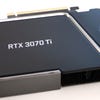Nvidia GeForce RTX 3070 Ti review
A price premium for a modest performance bump.
The idea of the Nvidia GeForce RTX 3070 Ti has obvious appeal. Positioned between the $500/£469 RTX 3070 and $700/£569 RTX 3080, the $600/£529 3070 Ti ought to offer noticeably better performance than the vanilla 3070 while being significantly more affordable than the 3080. The new card is also only $20/£0 more than the AMD's RX 6800, so there's potential here for Nvidia to offer equivalent performance in many games, plus better results in RT titles and a more mature feature set, at a broadly equivalent price.
Unfortunately though, the 3070 Ti doesn't really deliver on its premise, offering what is typically a single digit performance bump over the regular 3070 that simply isn't good enough given its 20 percent higher asking price - and that's without factoring in the normal Covid-era markups for graphics cards of any flavour. After a genuinely good value RTX 3060 Ti and an RTX 3080 Ti that brought 3090 performance to a lower price point, the 3070 Ti is therefore something of an unexpected combo-breaker.
Looking at the specs, we can start that Nvidia's latitude in delivering a midway point between RTX 3070 and 3080 was fundamentally limited. Rather than being a cut-down version of the RTX 3080's GA102 GPU, the 3070 Ti is instead a fully-enabled version of the RTX 3070's GA104. The CUDA core count jumps only 4.3 percent, from 5888 to 6144, compared to 8704 on the RTX 3080.
Of course, raw compute power isn't everything, and we do so more significant changes elsewhere - including in the memory subsystem where Nvidia has opted for GDDR6X here instead of plain old GDDR6 on the 3070. That results in a tremendous uplift to memory bandwidth - 608GB/s versus 448GB/s - but this more expensive memory no doubt contributes a fair amount to the 3070 Ti's $100 higher MSRP. Boost clocks are also 45MHz higher and the card is allowed to suck down 32 percent more power, as the card's TDP shifts from 220W to 290W. That looks pretty promising, but remember that the higher bandwidth afforded by GDDR6X also results in greater power draw - so it may be that relatively little is left over for the rest of the GPU to utilise.
That higher power target also means more heat, and to compensate for this Nvidia has opted for a new take on its familiar RTX 30-series Founders Edition chassis. The card is physically larger than the RTX 3070, but not quite as large as the 3080. It's rare to see a unique design for one card as we have here, so it's possible that this will be reused elsewhere down the road - as we saw with the RTX 2060 and 2060 Super last generation. Like its brethren, the 3070 Ti FE uses Nvidia's 12-pin power input (provided with a dual 8-pin adapter) and the standard assortment of one HDMI 2.1 port and three DisplayPort 1.4 ports for connectivity.
With the costs of faster VRAM and a new chassis to fit into a $100 premium, it's perhaps not surprising that we don't also see a shift from 8GB to 10, 12 or even 16GB of VRAM. The 8GB of video memory on the RTX 3070 was one of the few criticisms levelled at the original design, so it's still a bit of a shame not to see a higher allocation here. Of course, there are significant design implications for additional memory beyond just the extra cost, so clearly it didn't make sense to Nvidia's engineers in this instance.
The only one thing left to mention in terms of the hardware here is that we're again looking at an Ampere-class graphics card, so you get the usual third-gen Tensor cores, second-gen RT cores and industry-leading NVEnc encoders plus AV1 decoding.
| RTX 3080 | RTX 3070 Ti | RTX 3070 | RTX 3060 Ti | RTX 2070S | RTX 2070 | GTX 1070 | |
|---|---|---|---|---|---|---|---|
| GPU | GA102 | GA104 | GA104 | GA104 | TU106 | TU106 | GP106 |
| CUDA cores | 8704 | 6144 | 5888 | 4864 | 2560 | 2304 | 1920 |
| VRAM | 10GB GDDR6X | 8GB GDDR6X | 8GB GDDR6 | 8GB GDDR6 | 8GB GDDR6 | 8GB GDDR6 | 8GB GDDR5 |
| Memory Bus | 320-bit | 256-bit | 256-bit | 256-bit | 256-bit | 256-bit | 256-bit |
| Bandwidth | 760GB/s | 608GB/s | 448GB/s | 448GB/s | 448GB/s | 448GB/s | 256GB/s |
| Boost Clock | 1710MHz | 1770MHz | 1725MHz | 1665MHz | 1620MHz | 1770MHz | 1683MHz |
| TDP | 320W | 290W | 220W | 200W | 215W | 175W | 150W |
| Die Size | 628mm2 | 392mm2 | 392mm2 | 392mm2 | 445mm2 | 445mm2 | 314mm2 |
| Transistors | 28B | 17.4B | 17.4B | 17.4B | 10.8B | 10.8B | 7.2B |
As you might have gathered, our test rig has remained unchanged from our RTX 3080 Ti review last week, but here's a quick run-down if you're new here. We use a Core i9 10900K system as this provided the best out-and-out gaming performance when current-gen GPUs launched back in 2020, backed with an Asus Maximus 12 Extreme Z490 motherboard, dual-channel G.Skill Trident-Z Royal DDR4-3600 CL16 memory and a 2TB Samsung 970 Evo Plus NVMe drive from Box. To keep our CPU performance constant, we've locked it to 5GHz on all cores and kept it cool with a 240mm Eisbaer Aurora liquid cooler.
Now that you're familiar with the premise, the hardware and our testing apparatus, let's get onto the results!
Nvidia GeForce RTX 3070 Ti analysis
- Introduction and hardware analysis [This Page]
- Doom Eternal, Control, Borderlands 3, Shadow of the Tomb Raider - Game Benchmarks Part 1
- Death Stranding, Far Cry 5, Hitman 2, Assassin's Creed Odyssey - Game Benchmarks Part 2
- Metro Exodus, Dirt Rally 2, Assassin's Creed Unity - Game Benchmarks Part 3
- Resizable BAR benchmarks and requirements
- Control, Metro Exodus, Battlefield 5 - RT game benchmarks
- Nvidia GeForce RTX 3070 Ti - the Digital Foundry verdict















